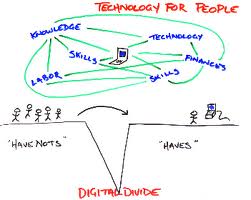
Introduction

This paper examines the impact of computing on societal equity, access, and power by focusing on the Global Digital Divide, an aspect of the phenomenon referred to as digital divide. A digital divide is an economic and social inequality according to categories of persons in a given population in their access to, use of, or knowledge of computing/technology.[1][2] The divide within countries (such as the digital divide in the United States) may refer to inequalities between individuals, households, businesses, or geographic areas, usually at different socioeconomic levels or other demographic categories. The divide between differing countries or regions of the world is referred to as the Global Digital Divide[1][3] and is the focus of this term paper for CSC101.
Section 2 provides background on the global digital divide. Section 3 describes proposed solutions. Section 4 is my analysis of the impact of computing on equity access and power as influenced by the global digital divide. In Section 5 I relate topics from my paper to lessons I have learned in CSC101. Section 6 concludes.